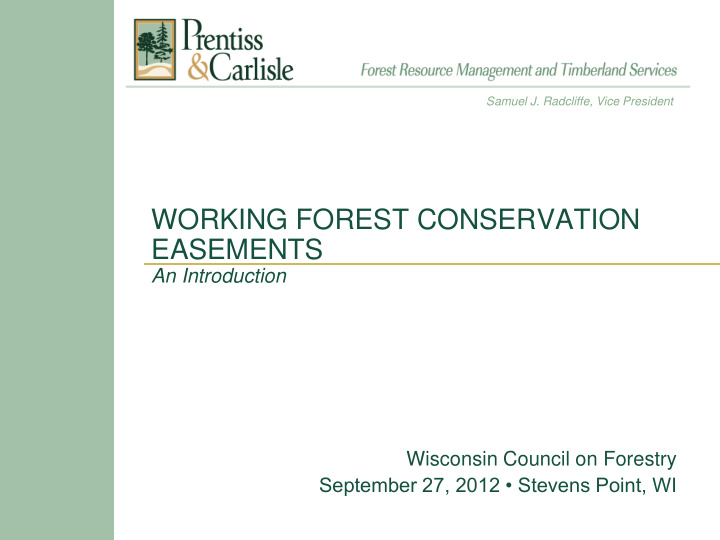



Samuel J. Radcliffe, Vice President WORKING FOREST CONSERVATION EASEMENTS An Introduction Wisconsin Council on Forestry September 27, 2012 • Stevens Point, WI
Overview Introduction What are WFCE’s? Who is involved? How do easements operate? When did they become popular? Where are they? Why do parties buy/sell easements? 2
Introduction to Prentiss & Carlisle • 1.5 million acres under management • consulting / due diligence • woods operations division • centralized wood marketing • company-owned land 3
What are WFCE’s? Voluntary, not eminent domain Deeded rights to a property; easement runs with title Easement should avoid language that is ambiguous or leaves “muddled middle ground in which an indecisive judge can wallow” http://www.perc.org/pdf/land_trusts_02.pdf Major focus: restrict development while allowing/encouraging/requiring forestry Secondary focus – public recreation – protection of unique or sensitive features – landscape connectivity – assure sustained timber supply 4
The“bundle of rights” concept http://goo.gl/tCQW0 5
Who is involved? Sell Side: Grantor – large landowner • ability to make significant conservation impact • realize economies of scale relative to transaction and administrative costs – sophisticated • legal questions • investment analysis • forest management Buy Side: Grantee – often conservation group initiates, finances – public agency typically the ultimate easement owner 6
How do easements operate? Administrative Features baseline report – environmental/ecological – timber inventory/growth – access long term plan, periodically updated mix of rights/responsibilities/costs regular monitoring annual meetings – compliance review – easement revision 7
How do easements operate? Regulatory Elements subdivision and development public access non-forestry uses – recreation – timber production related – mining, agriculture zoned areas – riparian – high elevation – recreational corridors forestry standards 8
Forestry Standards Vary http:// www.forestguild.org/publications/research/2006/Forest_Conservation_Easements_Forest_Guild.pdf 9
When did they become popular? http://www.landtrustalliance.org/land-trusts/land-trust-census/national-land-trust-census-2010/charts-and-graphs 10
Some Landmark WFCE’s in the North Year Acres State Seller Buyer 1999 139,000 New York Champion International State of NY 2001 762,192 Maine Pingree Family New England Forestry Foundation 2002 329,000 Maine Merriweather, LLC Forest Society of Maine 2002 146,000 New Hampshire TPL / Lyme Timber State of NH 2005 248,000 Michigan The Forestland Group TNC / State of MI 2006 59,023 Wisconsin International Paper TNC / State of WI 2007 278,000 New York Lyme Timber State of NY 2010 187,876 Minnesota UPM (Blandin) State of MN 2010 134,378 Minnesota Forest Capital Partners TNC / State of MN 2010 89,000 New York ATP Timberland Invest TNC / State of NY 2012 363,000 Maine Plum Creek Timber Co. Forest Society of Maine 2012 67,347 Wisconsin Lyme Timber Conservation Fund / State of WI 2,802,816 11
Where are they? National Extent http://databasin.org/protected-center/features/NCED 12
Where are they? Lake States 13
Where are they? New England 14
Why do parties buy/sell easements? Buyer of easement – greater awareness of complementarity between environmental values and (low intensity) working forests – directly address forest fragmentation – satisfy multiple constituencies – more acres per conservation dollar Seller of easement – return of capital lowers cost basis – transformation into “pure timber play” – potential to raise value of abutting lands or carve out high- value “kingdom lots” – benefits weighed against • transaction and administrative costs • options foregone • regulatory risk 15
Why do parties buy/sell eased properties? Is there a market? addresses demand for “pure timber play” mature market has minimized regulatory risk documented property performance may meet social investing criteria limited availability of institutional grade properties 16
Contact Samuel J. Radcliffe Vice President Prentiss & Carlisle 2912 E. Belleview Place Milwaukee, WI 53211 Voice & Fax 414.964.6400 Email sjradcliffe@prentissandcarlisle.com 17
Recommend
More recommend